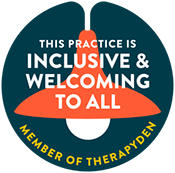This meditation is utilized in Compassion Focused Therapy. It helps to generate a sense of compassion when you are struggling with difficult emotions. It is especially useful when you are having a hard time with self-compassion, because you are drawing the compassion from an outside resource. Enjoy!
True Relaxation
When we think of what we do to relax, we tend to think of activities such as TV, baking, exercising, and more. While those are all identified by the general public as relaxation, oftentimes when mental health professionals refer to relaxation, we are discussing nervous system regulation.

The mind-body connection is real.
When our mind is stressed, our body is stressed and the opposite is also true, when our body is giving off stress signals, our mind begins to feel stressed as well. Furthermore, by engaging in nervous system relaxation, we can help our mind and body feel more relaxed. This can be a great wellness “hack” because if you are not able to get your mind to calm down, you can work to get your body to relax which will in turn help your mind to relax.
Let’s dive into a brief overview of human anatomy to better understand why nervous relaxation is so important.
Relaxing, as in nervous system relaxation, is finding ways to tap into the parasympathetic nervous system. Our body has a complex system of nerves and cells that work together to send messages throughout the body. The nervous system can be broken down into two sides: the central nervous system and the peripheral nervous system. Within the peripheral nervous system, there is the autonomic nervous system, which regulates involuntary body processes like heart rate, blood pressure, respiration, and digestion. The autonomic nervous system contains three parts, the sympathetic, parasympathetic, and enteric nervous systems. You may know the sympathetic nervous system as the “fight or flight response.” The opposite of fight or flight is relaxation and restoration, which is the parasympathetic nervous system.
Being able to truly relax has many benefits including restorative sleep, decreased inflammation, as well as better memory, auditory processing, learning, sensory processing, and more.
A large amount of people spend more time in fight or flight mode in their day-to-day life than not. When you are driving in traffic and notice you are clenching your jaw, or you end the day with neck pain because your shoulders were tense all day, or maybe you found yourself overthinking all day, you are engaging your sympathetic nervous system.
When we are stressed, our bodies tend to have more muscle tension, our blood goes towards the center of our bodies leaving our fingers and toes colder, we sweat more, our heart rate gets faster, and our breathing gets more shallow. Each person tends to experience stress differently, but we all have the same basic body responses to stress. By engaging in true relaxation, via nervous system regulation, you are allowing yourself to engage your parasympathetic nervous system (i.e., relaxation and restoration), which benefits you in so many ways.
There are a few different ways we can tap into our parasympathetic nervous system. Practicing present focus without judgment, otherwise known as mindfulness, is a great way to regulate your nervous system.
Mindfulness can look like many different things. It can mean something more formal like listening to a guided body scan meditation that leads you to breathe more slowly and deeply while releasing muscle tension. It can also be more informal like sitting outside and noticing the feeling of the temperature of the air on your skin, the smell of the leaves, the sounds around you, and the taste of your tea in the morning. Both of these experiences can help you tap into your relaxation and restoration mode because they are slowing you down. By slowing down and taking ourselves out of the hustle and bustle of everyday life, we can better notice the ways our body and mind are experiencing stress and tailor our relaxation to them.
When learning to truly relax, there are a few “entry points”.
Two of the easier ways to tap into your parasympathetic nervous system are through breathing and muscle tension. There are a few ways you can modify your breathing to get out of fight or flight mode. The first is through slowing your breathing. You can use an online breath pacer to help you, like this one.


It is a great tool that allows you to change the timing of the visual pacer to fit your needs. You want to practice breathing slower and deeper, but not so slow that it makes you feel more tense. With trial and error, you can find the right pace for you.
Another way to adjust your breathing, to tap into the parasympathetic nervous system, is by breathing through your diaphragm rather than your upper chest.
To practice diaphragmatic breathing, lay on your back while wearing loose clothing and place a book on your stomach (not too heavy!). Focus on what parts of your body are moving when you breathe naturally, is the book moving upwards as you inhale and down as you exhale? If not, see if you can focus on trying to move the book, rather than your chest with each breath. It may feel uncomfortable at first, but it is something that takes practice to feel natural. You are not expected to breathe this way all day but practicing it, periodically, throughout the day and in times of stress will help your body relax, which in turn helps your mind relax.
Additionally, you can tap into your parasympathetic nervous system by releasing muscle tension.
You can do this through something called a body scan or progressive muscle relaxation. To use these techniques, you can use apps like InsightTimer or videos on youtube to hear guided practices that will teach you how to release your muscle tension and become more aware of it.
These are both skills that take time to learn and feel natural. Just like you would not expect yourself to feel natural on your first day learning to ice skate, you will not feel like a professional at these types of relaxation techniques at first either. If you find yourself struggling to relax in these ways on your own but think it could be beneficial, mention it to your therapist if you have one. If not, you can also find a biofeedback provider who can use electronic tools to help you gain better awareness of your body’s response to stress which helps these relaxation techniques become even more effective.
You can find a provider near you through https://www.bcia.org/consumers-find-a-practitioner or you can contact our front desk to try heart rate variability biofeedback at Orchard Mental Health Group.
So continue to enjoy your hobbies and try and incorporate some true relaxation into your days, the benefits are well worth it!
Follow us for more wellness content!
More Blog Posts

A Compassion Meditation

Building Adolescent Emotional Resilience
Resilience is the ability to recoup following adversity such as elevated stress or trauma. Resilience does not mean that stress does not affect you or that you avoid struggles in life. Resilience is feeling confident that you are capable of effectively managing challenges and regulating emotions.

Reframing Your Thoughts: A Powerful Tool for Mental Health
Have you found yourself in a cycle of negative thinking that you can’t seem to break? This type of thought pattern, although common, can be destructive to a person’s psyche. Challenging these thoughts and unconstructive patterns is an instrumental component to break this cycle; a technique called reframing your thoughts.
In crisis or need immediate help?
Call 988 or go to your nearest ER.
Services
Adolescent Psychotherapy
Adult Psychotherapy
Assessments & Evaluation
Child Psychotherapy
Cognitive Behavioral Therapy
Couples Therapy
Family Therapy & Parent Coaching
Genetic Testing
Group Therapy
Medication Management
Play Therapy
Single-Session Therapy
Teletherapy
Orchard Mental Health Group
Accepted Insurance*
Aetna
Carefirst / Blue Cross Blue Shield
Cigna
Humana / Tricare
Johns Hopkins Health Plans
Medicaid
Medicare
Optum / UnitedHealthcare
*Varies by service
Partner Resources
Contact Us
M-F, 9am-5pm Eastern Time
Phone: 240-750-6467
Fax: 240-912-7835
contact@orchardmentalhealth.com
9707 Key West Avenue, Suite #100 Rockville, MD 20850









